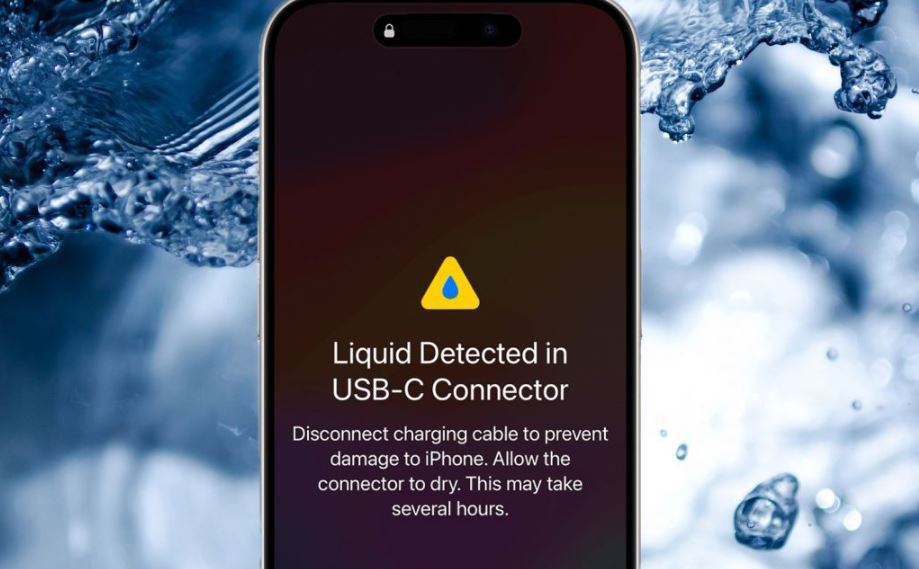Is the iPhone waterproof? What to do if it falls into water
29th May 2024
Peter Samos
There is a common concern about the possibility of an iPhone getting damaged if it falls into water.
This text will reveal whether the iPhone is genuinely waterproof and what actions should be taken if it encounters water.
By diving into details like the IP rating of the iPhone and examining water damage indicators, all crucial information will be covered to aid in protecting the device.
Continue reading to discover the proper way to deal with a water-damaged iPhone and the various methods that may be used to repair it.
Is the iPhone Waterproof?
In terms of iPhones, the question of whether they are waterproof is a common concern among users. Understanding the waterproof capabilities of your device can help you take appropriate precautions to avoid potential water damage.
It's essential to distinguish between waterproof and water-resistant. Waterproof means the device can withstand being submerged under water for a specific depth and time, while water-resistant implies it can resist water to a certain extent but may not be completely impervious. Knowing the IP rating of your iPhone for water resistance is crucial, as it indicates the level of protection it offers. If your device falls into water, act quickly by turning it off, drying it gently with a cloth, and avoiding excessive heat sources to prevent damage.
What Does 'Waterproof' Mean?
The term 'waterproof' concerning iPhones indicates the device's ability to endure submersion or exposure to water without damage. It is important to comprehend the specific water resistance capabilities and certification standards linked to your iPhone model.
For instance, iPhones are commonly evaluated using international standards like IP (Ingress Protection) ratings. An IP rating such as IP67 signifies that the device is dust-tight and can survive being submerged in water up to 1 meter for 30 minutes. Another prevalent standard is the MIL-STD-810G, which entails exposing the iPhone to various environmental tests, including water immersion. These certifications offer users a clear insight into the level of protection their device provides against water damage.
What Is the IP Rating of the iPhone?
The IP rating of an iPhone indicates its Ingress Protection against solids and liquids, showing the device's water resistance level. Understanding the IP rating of your iPhone can help in evaluating its susceptibility to water damage.
IP ratings range from IP67 to IP68, with the latter offering superior water resistance capabilities. An iPhone with an IP67 rating can endure being submerged in water up to 1 meter for 30 minutes, whereas an IP68-rated device can handle deeper submersion for longer periods. It's important to understand that although higher IP ratings offer better protection, they do not make a device completely waterproof. Factors such as water pressure, temperature, and the device's condition can still influence its resistance level, underscoring the importance of being cautious when exposing the device to water.
What to Do if Your iPhone Falls Into Water?
When an iPhone falls into water, prompt action is essential to prevent potential water damage and liquid infiltration. Knowing the correct steps to take can have a significant impact on the outcome and the functionality of the device.
The initial step is to retrieve the iPhone from the water as quickly as possible. It is advised not to attempt to turn it on or press any buttons, as this could result in a short circuit. Immediately power off the device to minimize the risk of internal damage. Avoid using a hairdryer or heat source for drying the iPhone, as heat can further damage the internal components.
Instead, gently pat it dry with a soft cloth and place it in a bowl of uncooked rice to assist in drying out any moisture. It is crucial to refrain from checking if the iPhone still works. By following these steps diligently, the chances of saving the device from irreversible damage can be increased.
Step 1: Retrieve the iPhone from the Water Immediately
The prompt retrieval of an iPhone from water is important to prevent further damage and improve the chances of successful recovery. Acting promptly helps avoid prolonged exposure to liquids that could cause internal damage.
Once the iPhone is removed from the water, the next important step is to immediately power off the device to prevent any short circuits. Liquid sensors located within the device are essential for detecting water exposure and warning of potential damage. These sensors are designed to respond rapidly to moisture, underscoring the importance of acting quickly.
After turning off the device, it is recommended not to attempt to test it to see if it is functioning. Instead, initiating the drying process promptly helps reduce the risk of corrosion and damage to internal components, ultimately impacting the device's longevity.
Step 2: Turn Off the iPhone
It is crucial to power off your iPhone after it comes into contact with water to minimize the risk of short circuits and hardware malfunctions. By shutting down the device, you decrease the likelihood of causing permanent damage to vital internal components.
Leaving the iPhone on following exposure to water can result in signal loss or device malfunctions. Continued operation of the iPhone post-water exposure may lead to electrical shorts and corrosion within the hardware, disrupting communication among the internal components and impacting the device's overall functionality.
To address signal problems, attempt toggling Airplane Mode on and off or resetting network settings. If the device continues to malfunction, consider restoring the iPhone using iTunes or reaching out to Apple Support for additional guidance.
Step 3: Dry the iPhone
Thoroughly drying an iPhone after exposure to water is essential to prevent internal moisture buildup and potential damage. Utilizing appropriate drying methods, such as rice or silica gel, can assist in effectively removing excess moisture.
A common DIY technique involves placing a water-exposed iPhone in a bag of uncooked rice, as rice functions as a desiccant that absorbs moisture from the device. Alternatively, silica gel packets, often found in shoeboxes or electronic packaging, have a higher absorption capacity than rice.
Before starting the drying process, it is important to ensure that the iPhone is powered off and any accessories are removed. Monitoring moisture indicators, typically located in the SIM card slot, can help assess the device's level of dryness. Regularly checking these indicators can assist in determining when the iPhone is completely dried and safe to power on again without risking further damage.
Step 4: Remove Any Accessories and SIM Card
It is important to remove all accessories and the SIM card from an iPhone that has fallen into water to prevent potential hardware damage and corrosion. Following the user manual guidelines on disassembly can help protect the device.
By following these steps, the risk of short circuits and internal damage caused by water exposure can be minimized. It is crucial to remember that leaving accessories connected or trying to power on the device before ensuring it is completely dry can worsen the situation. Acting swiftly is essential, as prolonged exposure to moisture can result in irreversible harm. Consulting the user manual for device-specific instructions is recommended to ensure a safe and effective disassembly process.
Step 5: Do Not Use Heat to Dry the iPhone
Avoid using heat sources such as hairdryers or ovens to dry a water-damaged iPhone, as excessive heat can cause further damage to internal components. With technological advancements, DIY repairs may seem feasible, but caution is advised.
While it may be tempting to tackle iPhone repairs independently, especially with the rise of easily accessible repair kits and online tutorials, it's essential to recognize the complexities of these devices. iPhones are intricate pieces of technology with delicate components that can be easily damaged if not handled correctly. Seeking professional help for water damage repair is crucial to prevent irreversible harm to the device and ensure that it continues to function optimally in the long run. Professionals have the expertise and tools needed to address water damage in a safe and effective manner, safeguarding your iPhone from further harm.
How to Check if Your iPhone Is Damaged?
Assessing the extent of damage to an iPhone after exposure to water is essential to determine the necessary repair actions. Conducting a thorough evaluation of hardware components and data recovery options can help salvage critical information.
Begin by carefully inspecting the exterior of the iPhone for visible signs of water damage, such as moisture under the screen or in the charging port. Next, power off the device immediately to prevent potential short circuits. Check for any hardware malfunctions by testing the buttons, speakers, and camera functionality.
Prioritize backing up data as soon as possible to prevent loss. Remember, quick action is crucial to minimizing the impact of water damage on the device. Seeking professional evaluation can provide expert insight and ensure a comprehensive repair plan.
1. Check for Water Damage Indicators
Examining the water damage indicators on an iPhone can help in identifying potential liquid exposure and internal damage. Detecting these indicators early can assist in estimating repair costs and determining the degree of liquid infiltration.
In iPhones, the water damage indicators are typically small stickers placed inside the device or on the SIM card tray. These stickers change color upon exposure to moisture, usually turning pink or red when in contact with water. By inspecting these indicators, users can easily determine if their device has encountered liquid.
Understanding the relationship between the color change of these indicators and potential repair expenses is essential. A red indicator indicates water damage, which may result in costly repairs or the need for a replacement device.
2. Test the Functionality of the iPhone
Testing the functionality of an iPhone after water exposure is crucial to identify any operational issues or malfunctions. Troubleshooting common problems and exploring replacement options can help restore the device's functionality.
After an iPhone has been exposed to water, it is essential to conduct a series of tests to determine if the device is operating normally. Begin by ensuring that all buttons, speakers, and ports are functioning correctly. It is important to pay close attention to the touchscreen responsiveness and camera quality. If any irregularities, such as erratic behavior or unusual noises, are noticed, it is recommended to perform additional diagnostic checks or seek professional assistance.
If the iPhone shows significant damage, such as persistent screen issues or hardware problems caused by water exposure, it may be necessary to consider replacing the device to avoid potential long-term usage complications.
3. Look for Any Visible Damage
After water exposure, it is essential to visually inspect the screen, speakers, or camera of your iPhone for any signs of damage. Promptly identifying and addressing visible issues can help prevent further deterioration.
Water exposure can result in various problems like screen discoloration, audio distortion, or blurry camera output. If any of these issues are noticed, immediate action is important. For screen damage, check for cracks, black spots, or lines. Speaker issues may present as muffled sound or complete absence of sound. Camera malfunctions can manifest as foggy or blurry images.
To minimize these damages, power off the device, gently wipe off any visible water, and refrain from using heat sources for drying. If the damage is extensive, seeking professional assistance may be necessary.
Can You Fix a Water-Damaged iPhone?
Dealing with water damage on an iPhone necessitates prompt action and consideration of repair options. While DIY methods like the rice or silica gel approach can be tried, seeking professional assistance may offer a more effective solution.
It is important to act quickly upon discovering water damage, as delays can worsen the situation. DIY techniques, such as placing the device in uncooked rice or using desiccants like silica gel, are commonly suggested, but they may not always produce successful results. Attempting self-repairs without sufficient expertise can cause further internal damage to the device. Seeking professional help ensures that the iPhone is thoroughly evaluated by trained technicians who can accurately assess and address the extent of the damage, thereby increasing the chances of full functionality restoration.
1. Rice Method
The rice method for drying a water-damaged iPhone involves placing the device in a container filled with rice to absorb excess moisture. While this method is commonly used, it may not guarantee the preservation of data or warranty coverage.
Despite its popularity, the rice method cannot ensure the complete protection of sensitive data stored on the device. Exposure to moisture may result in data corruption or loss, compromising valuable information. Relying solely on this technique might void the iPhone's warranty, as unauthorized attempts to repair or dry the device can violate the original warranty terms set by the manufacturer.
Hence, users should be cautious and consider alternative methods for data security and warranty protection when dealing with water-damaged iPhones.
2. Silica Gel Method
Using silica gel packets to dry a water-damaged iPhone is an alternative method for effectively absorbing moisture. This method provides enhanced protection against potential damage and can be included as part of preventive measures to protect the device.
Silica gel is recognized for its excellent moisture absorption capabilities, making it a dependable option for drying electronics such as iPhones. By placing the water-affected device in a sealed container with silica gel packets, moisture is efficiently removed, decreasing the likelihood of corrosion and short circuits within the phone. This technique not only assists in restoring functionality but also aids in preventing lasting damage from prolonged water exposure. It is recommended to have silica gel packets readily available for immediate use in the event of accidental water exposure to electronic devices.
3. Alcohol Method
The alcohol method for addressing liquid damage on an iPhone involves using isopropyl alcohol to displace moisture and accelerate the drying process. This technique is suitable for emergency situations but requires careful application to prevent further damage.
When utilizing the alcohol method, it is crucial to exercise caution and ensure that the iPhone is powered off before proceeding. Begin by dabbing a small amount of isopropyl alcohol on a soft cloth, avoiding direct contact with the device's ports or openings. Gently wipe the affected areas, such as the charging port or speakers, to help evaporate any trapped liquid.
It is essential to avoid excessive use of alcohol and to allow the device to dry completely before attempting to power it on. Remember, swift action and careful handling are key to increasing the chances of a successful recovery from liquid damage.
4. Professional Repair
Choosing professional repair services from an authorized service provider can provide comprehensive solutions for water-damaged iPhones. These professionals are able to assess the damage, offer repair options, and ensure warranty coverage when applicable.
Authorized service providers not only have the technical expertise needed to accurately evaluate the extent of water damage but also possess the necessary tools and genuine replacement parts to carry out repairs effectively. By entrusting your iPhone to professionals, you can have peace of mind knowing that the repair costs are transparent and reasonable.
Opting for reputable professionals ensures that the device restoration is done in line with industry standards, reducing the risk of future issues and preserving the integrity of your device.















